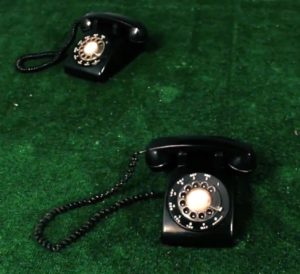Western Electric is a generative composition for fifteen modified and computer-controlled rotary telephones. The speed and position of the clappers are voltage-controlled, making possible a wide range of rhythms and tones. This expanded sound palette is used as the material for a structure based on the swarm behaviors of relatively simple organisms such as crickets or fireflies. Each telephone is ‘aware’ of what its neighbors are doing sonically, and determines its actions based on those of its neighbors.
Western Electric posits an alternative reality in which obsolete instruments present an atavistic sentience – not the product of an advanced consciousness of communication, but rather of a primitive will with not quite transparent intentions, a hive mind of the obsolete.
May 26 – July 23 2017
Fri. Sat. Sun and Holiday Mondays noon – 5 pm
Nolan Park Building 7a
Governors Island New York Ferry Schedule
 The telephones are linked to a computer controlling the sonic output of the bells. Old telephones sound via mechanical rather than electronic means: their bells are struck by clappers. In this work, the telephones have been modified so that the speed and position of the clappers can be voltage-controlled, making possible a wide range of rhythms, sounds and tones – from single peals to muted taps to familiar rings.
The telephones are linked to a computer controlling the sonic output of the bells. Old telephones sound via mechanical rather than electronic means: their bells are struck by clappers. In this work, the telephones have been modified so that the speed and position of the clappers can be voltage-controlled, making possible a wide range of rhythms, sounds and tones – from single peals to muted taps to familiar rings.
This expanded sound palette is used as the material for a compositional structure based on several different algorithms, most of which are designed to model swarm behaviors of relatively simple organisms such as crickets or fireflies. Each telephone is ‘aware’ of what its neighbors are doing sonically, and determines its actions based on a Markov-type decision chain which weights its possible activities such as type of sound, frequency, and intensity based on the activities of its neighbors.
Western Electric posits an alternative reality in which obsolete instruments present an atavistic sentience – not the product of an advanced consciousness of communication, as we might wish or fantasize them to be, but rather allude to a primitive will with not quite transparent intentions, a hive mind of the obsolete.
 While maintaining Aristotelian unity – the work’s sonic content is a result of the telephone’s mechanical form — this piece aims to unfold this formal object by reshaping its familiar sonic and social relations, reconsidering it as orchestra, bedlam, and site of exchange. The combination of the estranging strategies of multiplication and re-purposing with the iconic visual and auditory qualities of the telephone presents a fresh interrogation of fundamental precepts, both artistic and social: musical composition, robotics, and the nature of our interaction with technology.
While maintaining Aristotelian unity – the work’s sonic content is a result of the telephone’s mechanical form — this piece aims to unfold this formal object by reshaping its familiar sonic and social relations, reconsidering it as orchestra, bedlam, and site of exchange. The combination of the estranging strategies of multiplication and re-purposing with the iconic visual and auditory qualities of the telephone presents a fresh interrogation of fundamental precepts, both artistic and social: musical composition, robotics, and the nature of our interaction with technology.
BIO
A New York City native, Matthew Ostrowski has been creating art with electronic and digital media for over twenty years, having worked as a composer, performer and installation artist, exploring work with music, multimedia, video and theater. Using digital tools and formalist techniques to engage with quotidian materials — sonic, physical, and cultural – Ostrowski’s work explores the liminal space between the virtual and phenomenological worlds.
His work ranges from live electronic performance to installations incorporating video, multichannel sound, and computer-controlled objects. Ostrowski has collaborated with a large number of artists in the US and abroad, including David Behrman, John Butcher, Diamanda Galás, Nicolas Collins, Anne LaBerge, The Flying Karamazov Brothers, and many others. He was composer-in-residence for the MacArthur-award winning choreographer Elizabeth Streb, and has designed interactive technologies for performing and fine artists ranging from Laurie Anderson to Martha Rosler. He regularly performs in the duo KRK, with Prague-based contrabassist George Cremaschi, and with R. Luke Dubois in the multimedia duo Fair Use.
Ostrowski’s productions have been seen or performed on six continents, including the Wien Modern Festival, Transmediale and Maerz Musik in Berlin,the Kraków Audio Art Festival, Sonic Acts in Amsterdam, PS 1 and The Kitchen in New York , the Rencontres Internationales video festival in Madrid, and Yokohama’s dis_locate Festival. He has received numerous awards, including a NYFA Fellowship for Computer Arts.
ADDITIONAL MATERIAL





